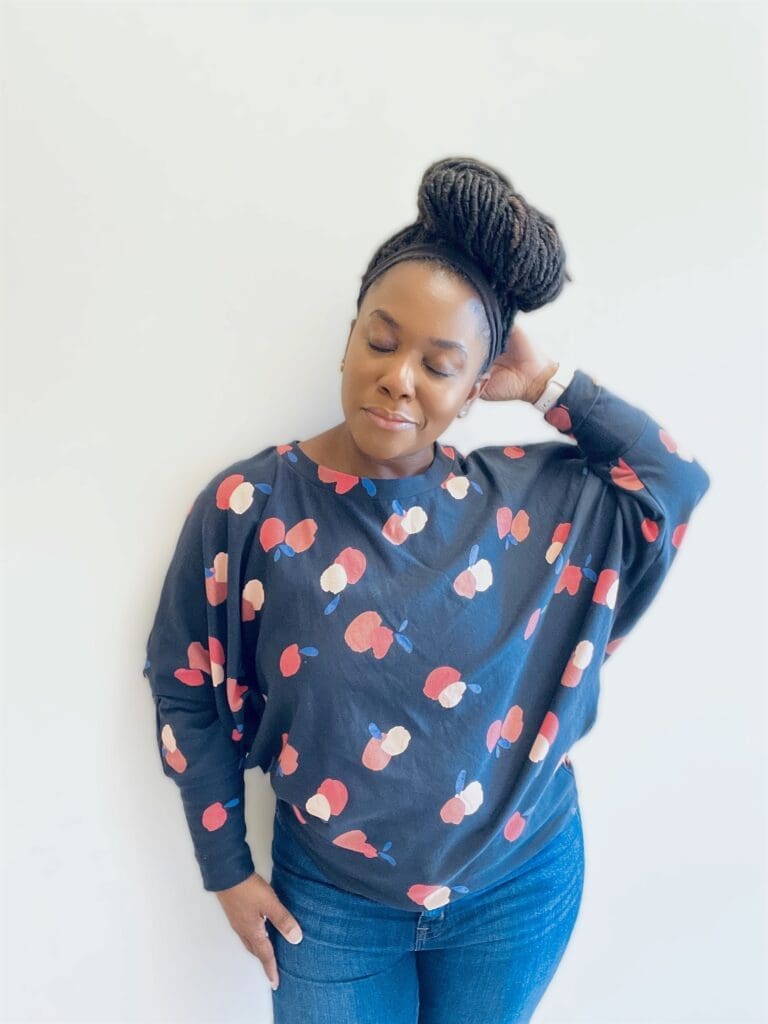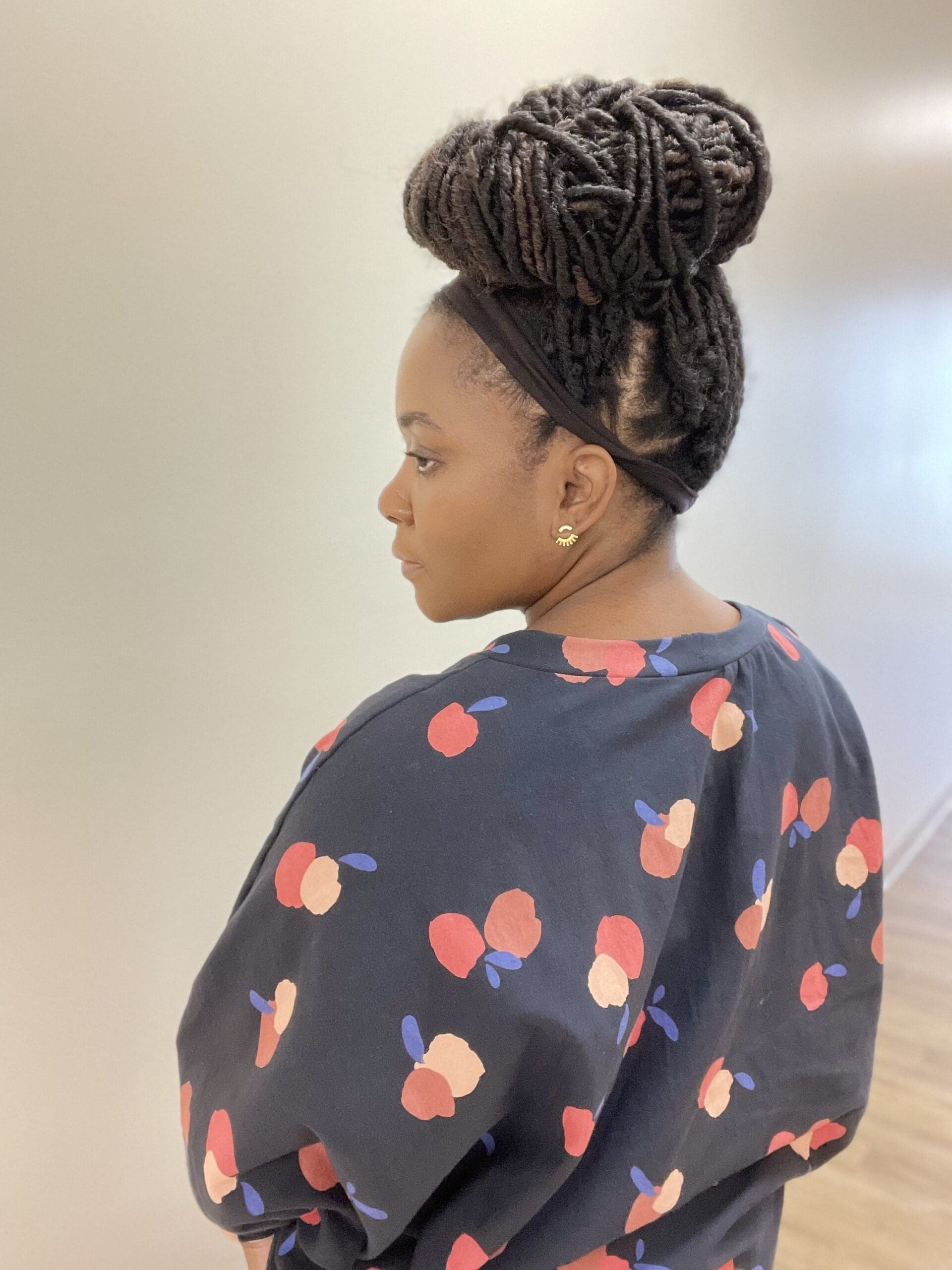Sewing with Knits 5 Incredible Secrets: A Guide

Why do we need a guide to sewing with knits? Well, you know why. When you first start sewing, people always have ideas about what you should sew and what kind of fabric you should use. That’s why we need a primer of sorts. We are mostly persuaded to start with a woven fabric, apron, or flannel PJ bottom that you hate and will never use.
This post is not to bash wovens or aprons, but to be fair, knits have a lousy reputation when sewing.
Like poplin, cotton, linen, and wool, wovens are stable friends. They do what they are expected to do and usually nothing else. They don’t stretch on the grainline and also stay together nicely under your feed dog.
However, I think that sewing knits are better than sewing woven for a beginning sewist. Why?
5 Reasons to Love Sewing with Knits
Knits are forgiving.
Like a sin, on Sunday, they forgive you every time. I mean, they stretch on your body and on the machine. If it is not cut correctly, there is a good chance no one will ever know (yes, I’ll keep your secret). In my early years, I can not tell you how often the fabric was accidentally hanging off my then makeshift sewing table, and a piece was cut too short or too (fill in the blank).
I’m not suggesting we get sloppy in our art and execution, I’m just sayin’ sometimes it’s like that, and no one wants to wad up a project over a few inches.
Knits drape & twirl.
Oh, the things you can sew with knits with some creative draping. Don’t get me wrong. You can obviously drape woven, all kinds of cottons, and other types of stable fabrics, but draping a printed knit is beautiful. There is so much movement when you get it right. The reward of the twirl is enough to use the fabric.
Knits (usually) don’t ravel or snag easily.
Most knits can be cut without worrying that the entire piece will unravel before your eyes. Unlike our woven buddies, when you sew with knits, you don’t have to serge or finish them, although it often looks polished if you do. Below is Butterick 6213 that I didn’t hem, which worked for the look I was going for.
Knits keep you warm.
Honestly, this is not my favorite thing about knits. I live on an island–a literal island. Therefore sewing with knits in the winter means something different, temps run between 58-75 degrees. We wear sandals and shorts in the winter. HOWEVER, on that breezy, chilly day when you want to be snuggled in a POLYESTER knit, it’s a ready-made heat box. Since they come in different weights and textures, you may not be super warm, but there is a good chance you won’t be cold.
Knits are easy to sew.
Yes, you read that right. Knits are very easy to sew; with a few tips and tricks, anyone can successfully complete a sewing project using knit fabric. If this is your first or 50th project sewing with knits, you can benefit from the following tips.
Sewing with knits: What is a knit fabric?
Interlocking looped yarns make knit fabrics. As already stated, they generally stretch and have either 1 or 2-way stretch. They come in a variety of forms, such as:
- Ponte
- thermal/waffle
- double knit
- sweater knit
- rayon
- bamboo
- modal
- rib knit
- swimwear knit.
- Jersey (matte, rayon, cotton, or blend)
- ITY (interlock twist yarn, usually polyester)
Some knits are more stable than others, such as heavyweight Ponte. The more stable knits are perfect for jackets, structured pants, and dresses. Other knits, such as ITY have more drape and move more. The lighter-weight knits are perfect for t-shirts, pajamas, dresses, skirts, leggings, and pants (not fitted).
Choose the right knit.
Think about it, to make the most of your project, you have to make sure you choose the correct type of knit. The pattern envelope will suggest the fabric you need to use, but there are also other clues to make your sewing project successful. If the pattern calls for a 2-way stretch material, pick a fabric that stretches in both directions to ensure the proper fit. Test the stretch in both the crosswise and lengthwise directions.
Grain and the knit gauge
Pay attention to the stretch knit gauge on the pattern envelope.
Pick the correct knit fabric by holding the material firmly in your left hand and against the pattern envelope. Then, test the stretch by folding 3″ – 4″ of the project fabric against the crosswise edge gauge.
Stretch it to the right against the indicator. The material should stretch beyond the designated requirement. If it passes the symbol, it may be used for the project.
A word of caution, when testing the stretch, be careful not to distort the pattern, print, or ribs. Overstretching the fabric may give you the false sense that the fabric will work.
Watch the quick video below:
How to cut knit fabric?
Cutting knit fabrics can be tricky. If you think sewing with knits a challenge, trying cutting it. They are slinky and tend to become misshapen with stress, particularly if they have lots of stretch.
Identify the right side of the fabric.
My fabric marking trick is using a small piece of clear removable tape to mark the side that rolls.
Trust me. Mark it, especially if it’s black or if you can’t tell just by looking. You can also use chalk, a friction marker, or a fabric pen.
Respect the grainline when sewing with knits
Next, find the grainline of the fabric. Cutting the fabric on the proper grainline will make the fabric hang properly. Stripes, plaids, and other patterns accurately line up when cutting on the grainline.
Using pattern weights is a must. Knit fabric moves a lot. This is not the time to cowboy/cowgirl cut. I’ve done this many times and found that my fabric pieces were too large or too small. Disaster!
Also, ensure the fabric does not hang off the cutting surface. This creates stretch, distorts the grainline, and later creates abnormally small cut pieces. Mind the stretch and pay close attention while cutting.
Use a rotary cutter when cutting out the fabric. I know someone just sighed.
Rotary cutters aren’t just for quilters. Listen, Linda, when handled correctly, that rotary cutter is a savior for projects like these. For me, as the scissors graze the table, no matter how many pattern weights I put there, the fabric moves. ‘I ain’t got time for that,’ so I use the rotary cutter like a boss.
The key to using the rotary cutter is the pressure applied, the angle of tension, and the use of a fresh blade.
Which interfacing should you use when sewing knit fabric?
Some sewing projects will require interfacing to stabilize the project details. These include zipper openings, plackets, collars, tabs, buttonholes, and pockets. Using the wrong interfacing can make the area super stiff, defeating the purpose of using a stretch fabric.
Personally, I like to use fusible tricot like FusiKnit. The interfacing should stretch and should be lightweight. Remember to check the stretch direction of the stretch of the interfacing; otherwise, you may end up with an unstretchable pattern piece. Always test your interfacing on a scrap before putting it into your garment.
Top 3 Pro Tips for Sewing with Knit Fabrics:
1. Prewash to prevent shrink and curl.
I repeat, prewash these items UNLESS the manufacturer recommends another method of cleaning. THEY- WILL- SHRINK. I know sewists who don’t prewash, and I just don’t understand why you would want a smaller project after you spend all that time sewing. Also, the pressing process will shrink the fabric, so don’t get into the habit of not preshrinking. It is so disheartening when you cut the pieces correctly, and they shrink as you press them and put them together.

Normally, I prewash my knits in whatever manner I plan to wash the fabric later. What? Yes, if it’s a wool jersey, I will dry clean it, or cold water wash it and lay it flat to dry. If it’s a 100% polyester ITY, I will wash it on hot and dry it on high. Yes, hot and high. Mistakes happen in my house with the laundry.
Sometimes things are washed and dried incorrectly. This way, I know that no harm will come to my precious make if it is laundered improperly.
2. Use a walking foot.
Secondly, prevent the slip and slide of the fabric by using a walking foot or adjusting your feed dog; Slipping is a project nightmare. It distorts the seams, seam allowance, and ease of the garment. Ultimately, whatever you make won’t look right, no matter how well you cut it, because the seam allowance is off.
If your sewing machine doesn’t have one, you may have to order it online as an additional accessory. Your local sewing machine dealer can help you locate one too.
3. Use the correct needle type.

Next, analyze your tools. Use a ballpoint or jersey needle (stretch needle) or, at a minimum, use a new needle for your project. This prevents pulling, snagging and skipped stitches. Because the needle is blunt, it also prevents the needle from punching little holes in the fabric. To be honest, I don’t always use a stretch needle but guaranteed on expensive modal, jersey, silk jersey, a wool jersey, or other rare stretch fabric, do it. It’s like one less machine “snag” (pun intended) you don’t have to worry about.
Some Fantastic Patterns to Sew with Knits
Athleisure Knit: McCalls 8244


Sweatshirt Knit: McCalls 8024


One way stable knit: Know ME2013

